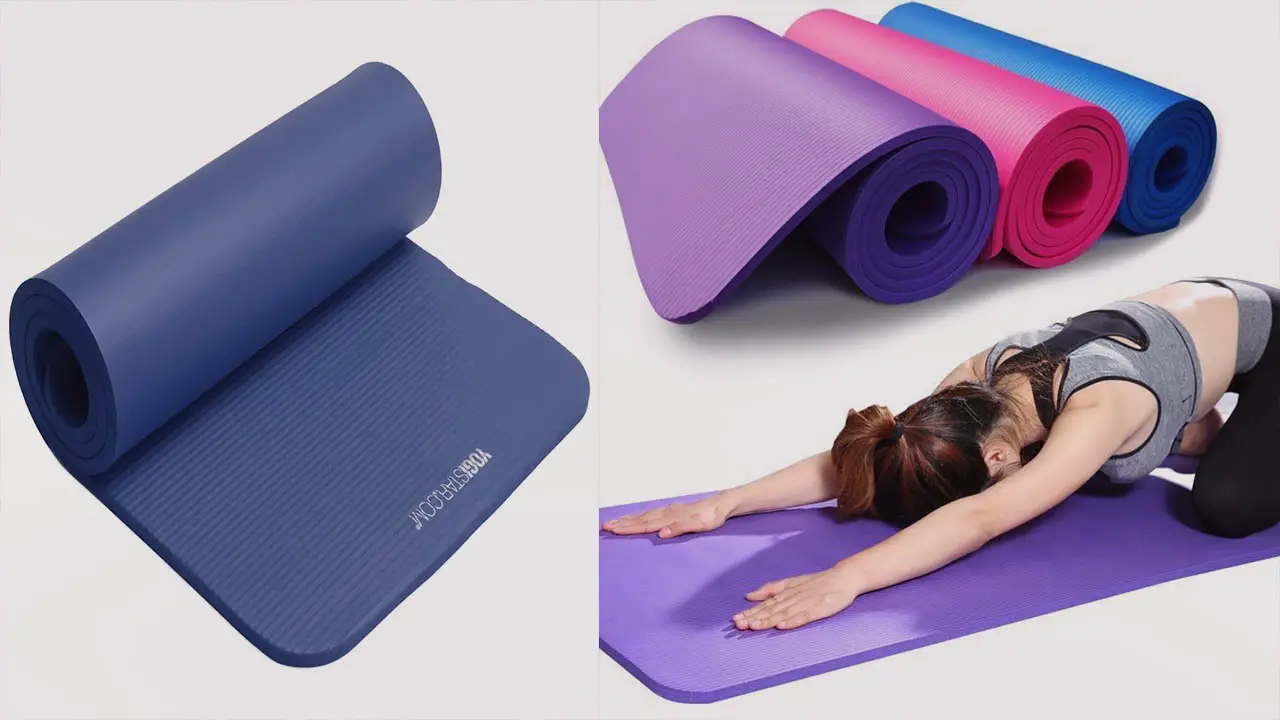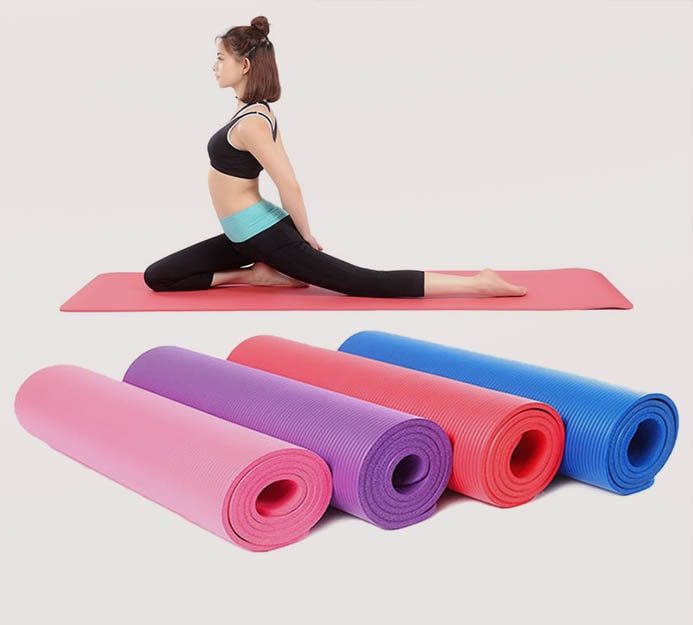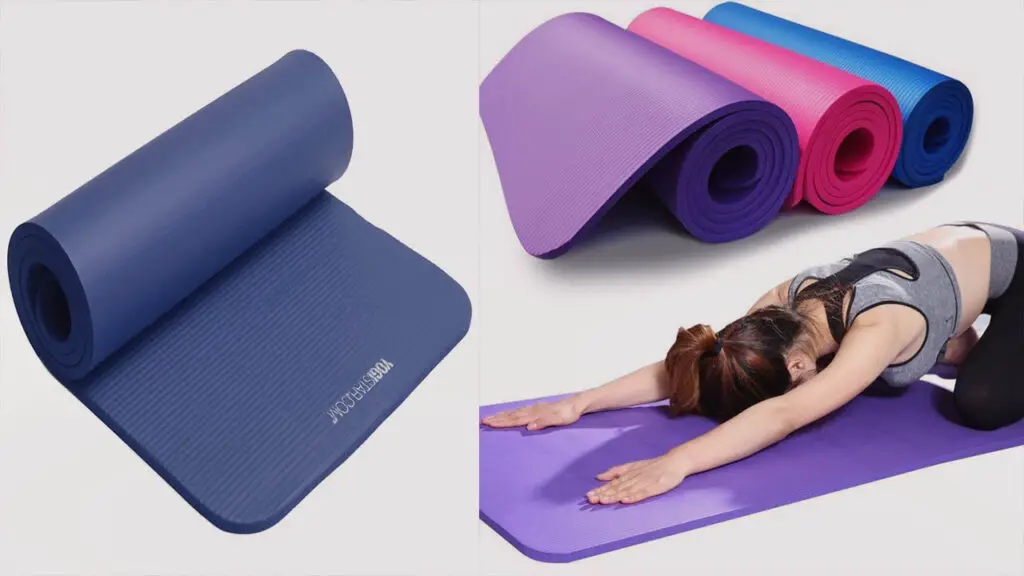When it comes to exercise routines, the right equipment can make a significant difference in your comfort and overall performance. Fitness Mat vs Yoga Mat are two commonly used accessories that provide cushioning and support during various types of workouts. While they may seem similar at first glance, there are distinct differences between fitness mats and yoga mats. In this article, we will explore these differences, and their specific uses, and help you determine which one is most suitable for your fitness needs.

What is Fitness Mat and Yoga Mat?
Fitness Mats
A fitness mat, also known as an exercise or workout mat, is a mat specifically designed to provide cushioning and support during high-impact exercises and intense physical activities. Fitness mats are primarily designed to provide a cushioned surface for high-impact exercises, such as aerobic workouts, HIIT (high-intensity interval training), Pilates, or any other type of intense physical activity. These mats are usually thicker and offer enhanced shock absorption to protect joints and reduce the risk of injury during energetic movements.

Fitness mats are typically thicker and denser than yoga mats. They often range from 8mm to 15mm in thickness, providing greater cushioning and impact absorption. The higher density helps to support the body weight and minimize strain on joints and pressure points during intense workouts.
Yoga Mats
Yoga mats, on the other hand, are specifically designed for yoga practice. They are thinner than fitness mats and offer a stable, non-slip surface for various yoga poses and meditation. Yoga mats focus more on providing grip and traction, allowing practitioners to maintain balance and stability during static postures and transitions.

Yoga mats are thinner, generally ranging from 3mm to 6mm in thickness. The reduced thickness allows for a better connection with the ground, enhancing stability and balance during yoga poses. While yoga mats may not provide as much padding as fitness mats, they are sufficient for the low-impact nature of yoga practice.
What is the Portability and Durability of a Fitness Mat vs Yoga Mat
Fitness Mats
Fitness mats are often bulkier and heavier due to their thicker and denser construction. They are designed to withstand rigorous exercises and heavy usage, making them more durable in the long run. However, their size and weight can make them less portable, especially for individuals who need to transport them frequently.
Yoga Mats
Yoga mats are typically lightweight and more portable, making them easier to carry to yoga classes, the gym, or other exercise locations. While they may not be as thick or durable as fitness mats, yoga mats are still designed to withstand regular use and provide adequate support during yoga sessions.
Differences Between Fitness Mat vs Yoga Mat
Purpose:
- Fitness mats are designed for high-impact exercises, such as aerobic workouts, HIIT, and Pilates, providing cushioning and shock absorption.
- Yoga mats are specifically tailored for yoga practice, offering stability, grip, and a non-slip surface for various yoga poses and meditation.
Thickness and Density:
- Fitness mats are generally thicker (8mm to 15mm) and denser to provide extra cushioning and support during intense workouts.
- Yoga mats are thinner (3mm to 6mm) to allow for better connection with the ground, enhancing stability during yoga poses.
Surface Texture:
- Fitness mats often have a textured or ridged surface to prevent slipping and improve grip during dynamic movements.
- Yoga mats typically have a smooth or slightly textured surface that offers a comfortable, non-slip grip for static poses and transitions.
Portability and Durability:
- Fitness mats are often bulkier and heavier due to their thicker and denser construction, making them less portable.
- Yoga mats are lightweight and more portable, designed for easy transport to yoga classes or the gym.
Similarities Between Fitness Mat vs Yoga Mat
Comfort:
- Both fitness mats and yoga mats provide a cushioned surface, offering comfort and support during exercises and yoga practice.
Non-Slip Surface:
- Both mats aim to provide a non-slip surface, ensuring stability and preventing injuries during workouts and yoga sessions.
Protective Function:
- Both mats help protect joints and pressure points by absorbing impact and reducing strain during physical activities.
Versatility:
- While each mat has its specific purpose, they can both be used for various exercises and stretching routines outside their primary focus.
Material Composition:
- Fitness mats and yoga mats are often made from similar materials like PVC, TPE, or natural rubber, ensuring durability and longevity.
Maintenance:
- Both mats are easy to clean and maintain, typically requiring a simple wipe-down with a damp cloth or mild cleaning solution.
Ultimately, the differences between fitness mats and yoga mats lie in their purpose, thickness, surface texture, and portability. Understanding these distinctions will help you choose the most appropriate mat for your specific exercise needs.
FAQ About Fitness Mat vs Yoga Mat
Is there a difference between a yoga mat and a workout mat?
Yes, there are differences between yoga mats and workout mats. Yoga mats are specifically designed for yoga practice, focusing on providing a stable, non-slip surface for various yoga poses and meditation. Workout mats, also known as fitness mats, are designed for high-impact exercises and intense physical activities, offering enhanced cushioning and shock absorption.
Which mat is best for exercise?
The best mat for exercise depends on the type of exercise you are engaging in. If you are primarily doing yoga or low-impact activities, a yoga mat would be suitable. For high-impact exercises like aerobics, HIIT, or Pilates, a fitness mat with extra cushioning and shock absorption is recommended.
What is a fitness mat?
A fitness mat, also known as an exercise or workout mat, is a mat specifically designed to provide cushioning and support during high-impact exercises and intense physical activities. It is typically thicker and denser than a yoga mat, offering better shock absorption to protect joints and reduce the risk of injury.
What’s the difference between yoga mats?
Yoga mats can vary in thickness, surface texture, and material composition. However, the main difference lies in their purpose and design. Yoga mats are specifically tailored for yoga practice, focusing on providing stability, grip, and comfort for various yoga poses and meditation. They are generally thinner and offer less cushioning compared to fitness mats.
Can we use a yoga mat for the gym?
While yoga mats are primarily designed for yoga practice, they can be used for some gym activities. Yoga mats provide a stable and non-slip surface, making them suitable for exercises that don’t involve high-impact movements or heavy equipment. However, if your workouts involve intense cardio, weightlifting, or other high-impact activities, a fitness mat would be more appropriate.
Why use a fitness mat?
Fitness mats provide several benefits during exercise. They offer cushioning and shock absorption, which help reduce strain on joints and pressure points, minimizing the risk of injury. Fitness mats also provide a comfortable surface for floor exercises, protect the body from hard surfaces, and help maintain stability during vigorous movements.
Which type of mat is best?
The best type of mat depends on your specific exercise needs. If you primarily engage in yoga or low-impact activities, a yoga mat would be suitable. For high-impact exercises or intense physical activities, a fitness mat with extra cushioning and shock absorption is recommended. Assessing your exercise routine and considering factors like thickness, surface texture, and portability will help you determine the best mat for your needs.
Which mat is best for a gym floor?
Gym floors typically require durable and thick mats to provide sufficient cushioning and protection. Fitness mats are generally the better choice for gym floors as they offer the necessary cushioning and shock absorption. Look for mats that have a non-slip surface and are designed to withstand heavy usage.
How thick is a fitness mat?
Fitness mats can vary in thickness, but they are typically thicker than yoga mats. The thickness of fitness mats can range from 8mm to 15mm, providing extra cushioning and shock absorption for high-impact exercises and intense physical activities.
Conclusion
Choosing the right mat depends on the type of exercise you intend to perform. Fitness mats are ideal for high-impact workouts and activities that require more cushioning and shock absorption. Yoga mats, on the other hand, are specifically designed for yoga practice, offering a stable and non-slip surface for static poses and transitions. Consider your specific fitness needs, preferences, and the type of exercise you engage in to make an informed decision. Ultimately, having a suitable mat will enhance your comfort, safety, and overall enjoyment during your fitness journey.



